Present simple present continuous
Download as pptx, pdf1 like3,678 views
Uitleg over het verschil tussen de present simple en de present continuous
1 of 12
Downloaded 36 times
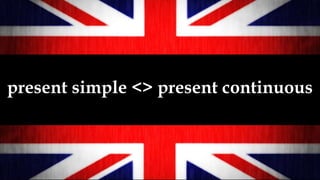



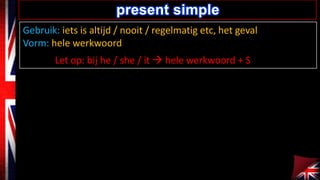
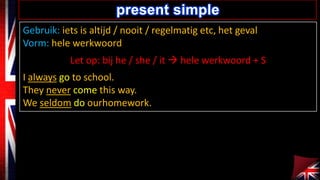
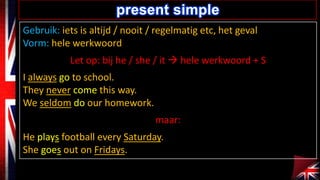
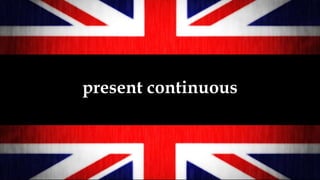
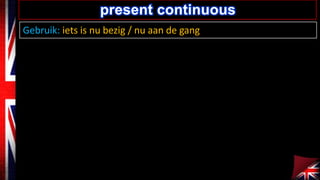
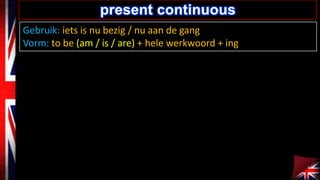
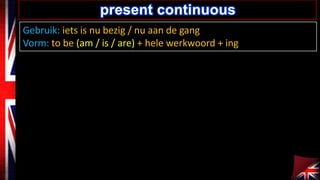
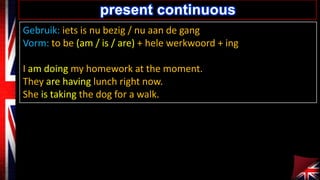
Ad
Recommended
Past continuous
Past continuousEnglish Grmmr
?
The document discusses the past continuous tense in English grammar. The past continuous tense is used to describe actions that were ongoing or in progress at a specific time in the past. It is formed using the past tense of the verb "to be" (was/were) plus the present participle form of the main verb ending in "-ing". Examples are provided such as "I was doing my homework when you came in" and "They were taking the dog for a walk when it started to rain".Present continuous
Present continuousEnglish Grmmr
?
The document discusses the present continuous tense in English. It notes that the present continuous tense is used to describe actions that are happening now or ongoing. It provides the form of the present continuous as "to be" verb (am/is/are) + main verb + "ing". Examples are given such as "He is doing his Math homework at the moment" and "They are having dinner right now". It also discusses how to negate the present continuous with "isn't/aren't" and form questions with "is/are".Foss start up-19092015
Foss start up-19092015nghia le trung
?
T¨¤i li?u tr¨¬nh b¨¤y l? do n¨ºn ch?n ph?n m?m t? do ngu?n m? cho ngh? nghi?p v¨¤ kh?i nghi?p, nh?n m?nh nhu c?u ng¨¤y c¨¤ng cao t?i Vi?t Nam v¨¤ c¨¢c c? h?i, th¨¢ch th?c trong l?nh v?c n¨¤y. N¨® c?ng ?? c?p ??n s? ti?n h¨®a c?a c¨¢c m? h¨¬nh kinh doanh ph?n m?m v¨¤ vai tr¨° c?a c¨¢c t? ch?c nh? VFOSSA trong vi?c h? tr? ph¨¢t tri?n ph?n m?m m? ngu?n m?. Th?ng tin li¨ºn l?c v¨¤ c¨¢c ngu?n t¨¤i nguy¨ºn li¨ºn quan ??n c?ng ngh? m? ngu?n m? c?ng ???c cung c?p.Foss dev-sustainability-model
Foss dev-sustainability-modelnghia le trung
?
T¨¤i li?u tr¨¬nh b¨¤y m? h¨¬nh ph¨¢t tri?n ph?n m?m ngu?n m? b?n v?ng v¨¤ ?? xu?t chi?n l??c ?ng d?ng cho n¨®. N¨® so s¨¢nh m? h¨¬nh ph¨¢t tri?n 'nh¨¤ th? l?n' v¨¤ 'c¨¢i ch?', nh?n m?nh t?m quan tr?ng c?a s? ?¨®ng g¨®p ng??c l¨ºn d¨°ng v¨¤ vai tr¨° c?a c?ng ??ng ng??i s? d?ng trong qu¨¢ tr¨¬nh ph¨¢t tri?n. Cu?i c¨´ng, t¨¤i li?u c?ng ?? c?p ??n quy tr¨¬nh chuy?n ??i ph?n m?m ngu?n ?¨®ng sang ph?n m?m ngu?n m?.Oer and-er-in-he-vn
Oer and-er-in-he-vnnghia le trung
?
T¨¤i li?u gi?i thi?u v? t¨¤i nguy¨ºn gi¨¢o d?c m? (OER) v¨¤ c¨¢c kh¨ªa c?nh li¨ºn quan ??n gi¨¢o d?c m?, t? kh¨¢i ni?m c? b?n ??n t¨¢c ??ng v¨¤ c? h?i trong gi¨¢o d?c ??i h?c. N¨® c?ng n¨ºu r? vai tr¨° c?a OER trong vi?c t?ng c??ng s? b¨¬nh ??ng trong gi¨¢o d?c, ti?t ki?m chi ph¨ª, v¨¤ n?ng cao ch?t l??ng t¨¤i li?u h?c t?p. Cu?i c¨´ng, t¨¤i li?u cung c?p th?ng tin v? c¨¢c gi?y ph¨¦p m? v¨¤ c?ng ngh? li¨ºn quan ??n OER.License system-foss-oer-present-th12-2012
License system-foss-oer-present-th12-2012nghia le trung
?
T¨¤i li?u gi?i thi?u v? h? th?ng gi?y ph¨¦p ph?n m?m t? do m? ngu?n m? (PMTDNM) v¨¤ t¨¤i li?u m?, nh?n m?nh c¨¢c quan ?i?m v? quy?n s? h?u tr¨ª tu?, s? c?n thi?t c?a gi?y ph¨¦p m? v¨¤ t¨¢c ??ng c?a n¨® ??i v?i ??i m?i s¨¢ng t?o. N¨® ph?n chia c¨¢c lo?i gi?y ph¨¦p th¨¤nh gi?y ph¨¦p d? d?i v¨¤ gi?y ph¨¦p m?nh, ??ng th?i tr¨¬nh b¨¤y chi ti?t v? c¨¢c gi?y ph¨¦p Creative Commons cho t¨¤i li?u. Cu?i c¨´ng, t¨¤i li?u khuy?n ngh? s? d?ng c¨¢c t¨¤i li?u m? trong gi¨¢o d?c v¨¤ nh?n m?nh t?m quan tr?ng c?a vi?c tu?n th? quy?n s? h?u tr¨ª tu?.More Related Content
What's hot (15)
Viewers also liked (18)
Past continuous
Past continuousEnglish Grmmr
?
The document discusses the past continuous tense in English grammar. The past continuous tense is used to describe actions that were ongoing or in progress at a specific time in the past. It is formed using the past tense of the verb "to be" (was/were) plus the present participle form of the main verb ending in "-ing". Examples are provided such as "I was doing my homework when you came in" and "They were taking the dog for a walk when it started to rain".Present continuous
Present continuousEnglish Grmmr
?
The document discusses the present continuous tense in English. It notes that the present continuous tense is used to describe actions that are happening now or ongoing. It provides the form of the present continuous as "to be" verb (am/is/are) + main verb + "ing". Examples are given such as "He is doing his Math homework at the moment" and "They are having dinner right now". It also discusses how to negate the present continuous with "isn't/aren't" and form questions with "is/are".Foss start up-19092015
Foss start up-19092015nghia le trung
?
T¨¤i li?u tr¨¬nh b¨¤y l? do n¨ºn ch?n ph?n m?m t? do ngu?n m? cho ngh? nghi?p v¨¤ kh?i nghi?p, nh?n m?nh nhu c?u ng¨¤y c¨¤ng cao t?i Vi?t Nam v¨¤ c¨¢c c? h?i, th¨¢ch th?c trong l?nh v?c n¨¤y. N¨® c?ng ?? c?p ??n s? ti?n h¨®a c?a c¨¢c m? h¨¬nh kinh doanh ph?n m?m v¨¤ vai tr¨° c?a c¨¢c t? ch?c nh? VFOSSA trong vi?c h? tr? ph¨¢t tri?n ph?n m?m m? ngu?n m?. Th?ng tin li¨ºn l?c v¨¤ c¨¢c ngu?n t¨¤i nguy¨ºn li¨ºn quan ??n c?ng ngh? m? ngu?n m? c?ng ???c cung c?p.Foss dev-sustainability-model
Foss dev-sustainability-modelnghia le trung
?
T¨¤i li?u tr¨¬nh b¨¤y m? h¨¬nh ph¨¢t tri?n ph?n m?m ngu?n m? b?n v?ng v¨¤ ?? xu?t chi?n l??c ?ng d?ng cho n¨®. N¨® so s¨¢nh m? h¨¬nh ph¨¢t tri?n 'nh¨¤ th? l?n' v¨¤ 'c¨¢i ch?', nh?n m?nh t?m quan tr?ng c?a s? ?¨®ng g¨®p ng??c l¨ºn d¨°ng v¨¤ vai tr¨° c?a c?ng ??ng ng??i s? d?ng trong qu¨¢ tr¨¬nh ph¨¢t tri?n. Cu?i c¨´ng, t¨¤i li?u c?ng ?? c?p ??n quy tr¨¬nh chuy?n ??i ph?n m?m ngu?n ?¨®ng sang ph?n m?m ngu?n m?.Oer and-er-in-he-vn
Oer and-er-in-he-vnnghia le trung
?
T¨¤i li?u gi?i thi?u v? t¨¤i nguy¨ºn gi¨¢o d?c m? (OER) v¨¤ c¨¢c kh¨ªa c?nh li¨ºn quan ??n gi¨¢o d?c m?, t? kh¨¢i ni?m c? b?n ??n t¨¢c ??ng v¨¤ c? h?i trong gi¨¢o d?c ??i h?c. N¨® c?ng n¨ºu r? vai tr¨° c?a OER trong vi?c t?ng c??ng s? b¨¬nh ??ng trong gi¨¢o d?c, ti?t ki?m chi ph¨ª, v¨¤ n?ng cao ch?t l??ng t¨¤i li?u h?c t?p. Cu?i c¨´ng, t¨¤i li?u cung c?p th?ng tin v? c¨¢c gi?y ph¨¦p m? v¨¤ c?ng ngh? li¨ºn quan ??n OER.License system-foss-oer-present-th12-2012
License system-foss-oer-present-th12-2012nghia le trung
?
T¨¤i li?u gi?i thi?u v? h? th?ng gi?y ph¨¦p ph?n m?m t? do m? ngu?n m? (PMTDNM) v¨¤ t¨¤i li?u m?, nh?n m?nh c¨¢c quan ?i?m v? quy?n s? h?u tr¨ª tu?, s? c?n thi?t c?a gi?y ph¨¦p m? v¨¤ t¨¢c ??ng c?a n¨® ??i v?i ??i m?i s¨¢ng t?o. N¨® ph?n chia c¨¢c lo?i gi?y ph¨¦p th¨¤nh gi?y ph¨¦p d? d?i v¨¤ gi?y ph¨¦p m?nh, ??ng th?i tr¨¬nh b¨¤y chi ti?t v? c¨¢c gi?y ph¨¦p Creative Commons cho t¨¤i li?u. Cu?i c¨´ng, t¨¤i li?u khuy?n ngh? s? d?ng c¨¢c t¨¤i li?u m? trong gi¨¢o d?c v¨¤ nh?n m?nh t?m quan tr?ng c?a vi?c tu?n th? quy?n s? h?u tr¨ª tu?.PT COMESTOARRA BENTARRA NOESANTARRA (comestoarra.com)
PT COMESTOARRA BENTARRA NOESANTARRA (comestoarra.com)PT COMESTOARRA BENTARRA NOESANTARRA (comestoarra.com)
?
Dear all ºÝºÝߣshare's Viewers wherever you are,
We are comestoarra.com, a professional partner for your company in order to enhance your B2B and B2C approaches. Our competences are Photography, Videography, Graphic Design, and Information Technology. It includes the competency in creating, developing, enhancing, and maintaining your branding, advertising, and marketing activities. Sustaining your competitive advantage is our goal.
For the further information, Please kindly to download our proposal (company profile and its portofolio)
Towards language education strategy and qa 1
Towards language education strategy and qa 1REFLESS Project
?
The document summarizes Serbia's system of quality assurance in higher education. It describes the internal mechanism of self-assessment conducted by higher education institutions every 3 years and the external mechanisms of accreditation by the Commission for Accreditation and Quality Assurance every 5 years and external quality assessment every 5-8 years. Standards for these processes are based on the European Standards and Guidelines. Results are presented for accreditation from 2007-2011 and external assessments from 2011-2013. Specific data is also given on accreditation of language education programs and institutions, including student numbers.Info sec foss-migration-dec-2013b
Info sec foss-migration-dec-2013bnghia le trung
?
B¨¤i tr¨¬nh b¨¤y v? an ninh kh?ng gian m?ng v¨¤ xu th? chuy?n ??i sang c?ng ngh? m? t?i NetNam, H¨¤ N?i, n¨ºu b?t c¨¢c v?n ?? nh? t?n c?ng m?ng, ph?n m?m ??c h?i v¨¤ gi¨¢n ?i?p c?a NSA. T¨¤i li?u c?ng ?? xu?t khuy?n ngh? cho Vi?t Nam li¨ºn quan ??n ph¨¢t tri?n c?ng ngh? m? v¨¤ lo?i tr? ph?n m?m ??c quy?n nh?m n?ng cao an ninh m?ng. Cu?i c¨´ng, t¨¢c gi? nh?n m?nh r?ng vi?c m? r?ng c?ng ngh? m?i s? t?o ra nhi?u c? h?i h?n cho t??ng lai.Which competences does the market demand an analysis of job advertisements wi...
Which competences does the market demand an analysis of job advertisements wi...REFLESS Project
?
This document analyzes job advertisements for translators and interpreters from 2009 to 2011 in Serbia. It found an increase in the number of ads and employers over this period. Most employers were located in Belgrade and Novi Sad, and sought translations primarily between English, German, Russian, Italian, and French. In-demand skills included translation, interpreting, writing and proofreading abilities. Advertisements also emphasized characteristics like organization, precision, willingness to learn, and being a team player. Common tools listed included MS Office, CAT tools like Trados and Wordfast, and subtitling software.Foss econ-sep-2016
Foss econ-sep-2016nghia le trung
?
T¨¤i li?u ph?n t¨ªch c¨¢c kh¨ªa c?nh kinh t? v¨¤ m? h¨¬nh kinh doanh c?a ph?n m?m m? ngu?n m?, bao g?m vi?c t?o ra gi¨¢ tr?, chi ph¨ª s?n xu?t v¨¤ s? c?nh tranh trong th? tr??ng. N¨® c?ng ?? c?p ??n c¨¢c y?u t? nh? hi?u ?ng m?ng, chi ph¨ª chuy?n ??i v¨¤ t¨ªnh t??ng th¨ªch gi?a c¨¢c s?n ph?m. Cu?i c¨´ng, t¨¤i li?u tr¨¬nh b¨¤y c¨¢c c? h?i kinh doanh trong b?i c?nh ph?n m?m t? do v¨¤ m?i li¨ºn h? v?i c¨¢c d?ch v? v¨¤ s?n ph?m b? sung.How to make "moon cake" Ô±ýʳÆ×
How to make "moon cake" Ô±ýʳÆ×Yuen Lian Chan
?
ÒªÖÆ×÷¼òµ¥ÓֺóԵÄÔ±ý£¬»¶Óä¯ÀÀ¡°Ô±ýʳÆס±£¬ÀïÍ·ÊÕ¼¯Á˺ܶà¸÷ʽ¸÷ÑùµÄÔ±ý£¬Óд«Í³µÄ£¬Óо¼ÃµÄ£¬ÓбùƤµÄ£¬ÓвËÑàµÄ¡£¡£¡£Appar - Fo?retagarna
Appar - Fo?retagarnaMobisleApps AB
?
Dragning om appar f?r F?retagarna i G?teborg 20:e September 2013.
-Vad ?r en app?
-App vs Mobilwebb
-Varf?r skall man ha en app?
-Exempel p? appar
-Hur tar man fram en app?
-Framtiden?
Cems entrepreneurs presentation
Cems entrepreneurs presentationariadnamaso
?
The document provides information about CEMS Entrepreneurs, a global platform connecting CEMS students, alumni, faculty, and corporate partners involved in entrepreneurship. It outlines the objectives to unite CEMS entrepreneurs and cultivate an entrepreneurial culture. Key information includes how members can connect, inspire, and collaborate with each other; potential benefits of joining for different groups; and how to become a member through the website or Facebook group. The team behind CEMS Entrepreneurs and their backgrounds are also summarized.Info sec foss-mandate-migration-nov-2013-
Info sec foss-mandate-migration-nov-2013-nghia le trung
?
T¨¤i li?u th?o lu?n v? an ninh th?ng tin v¨¤ xu h??ng chuy?n ??i sang ph?n m?m m? ngu?n m? t?i h?i th?o, nh?n m?nh th¨¢ch th?c t? c¨¢c ch??ng tr¨¬nh gi¨¢n ?i?p v¨¤ ph?n m?m ??c h?i. N¨® ?? xu?t chi?n l??c c?ng ngh? th?ng tin cho Vi?t Nam h??ng t?i vi?c lo?i b? ph?n m?m ??c quy?n v¨¤ l¨¤m ch? c?ng ngh? m?. Th?ng ?i?p ch¨ªnh l¨¤ khuy?n kh¨ªch c?ng ??ng c?ng ngh? m? c¨´ng ph¨¢t tri?n v¨¤ ??i m?t v?i nh?ng th¨¢ch th?c l?n.Ad
More from English Grmmr (20)
Vergelijken
VergelijkenEnglish Grmmr
?
Degrees of comparison, trappen van vergelijking, English grammar, grammatica, EngelsTreasure hunt
Treasure huntEnglish Grmmr
?
The document outlines the rules for a treasure hunt game involving picking questions from a board, answering them correctly to advance, and digging for treasures. It includes a series of example questions and answers focusing on grammar, vocabulary, and sentence structure. Participants must navigate through right and wrong answers to engage with the game.Present simple (English version)
Present simple (English version)English Grmmr
?
The document discusses the present simple tense and its two main uses. The first use is for repeated or habitual actions, with examples of the forms for "I" and third person singular subjects. The second use is for facts and opinions. Several links are also provided for an English grammar YouTube channel and social media profiles.Ordinals
OrdinalsEnglish Grmmr
?
The document discusses ordinal numbers, which indicate the position or order of things or people. Most ordinals are formed by adding "th" to the number, such as 4th and 10th. The exceptions are 1st, 2nd, 3rd, and numbers ending in 11th-13th, which do not add "th".Rangtelwoorden
RangtelwoordenEnglish Grmmr
?
The document discusses ordinal numbers or ranking words in Dutch. It states that ranking words are used to indicate order and are typically formed by adding "th" after the number. Some exceptions to this rule include first, second, third, fifth, eighth, ninth, twelfth and twentieth. It also provides a table noting the typical ordinal forms for numbers up to twentieth.Union jack
Union jackEnglish Grmmr
?
The document repeatedly discusses the Union Jack flag of the United Kingdom. In a very concise manner, it focuses solely on mentioning the Union Jack, with no other details provided about the flag itself or any related context over multiple sentences. The only information given is the repeated reference to the Union Jack.Telling the time
Telling the timeEnglish Grmmr
?
The document provides information about telling time in a digital format. It lists the hours from 1:00 to 12:00 and their equivalent times in a 12-hour and 24-hour format. It also explains what quarter past, half past, and quarter to mean. There is a short exercises section that asks the reader to state what time is shown for various times provided.Ad
Present simple present continuous
- 1. present simple <> present continuous
- 3. Gebruik: iets is altijd / nooit / regelmatig etc, het geval present simple
- 4. Gebruik: iets is altijd / nooit / regelmatig etc, het geval Vorm: hele werkwoord present simple
- 5. Gebruik: iets is altijd / nooit / regelmatig etc, het geval Vorm: hele werkwoord Let op: bij he / she / it ? hele werkwoord + S present simple
- 6. Gebruik: iets is altijd / nooit / regelmatig etc, het geval Vorm: hele werkwoord Let op: bij he / she / it ? hele werkwoord + S I always go to school. They never come this way. We seldom do ourhomework. present simple
- 7. Gebruik: iets is altijd / nooit / regelmatig etc, het geval Vorm: hele werkwoord Let op: bij he / she / it ? hele werkwoord + S I always go to school. They never come this way. We seldom do our homework. maar: He plays football every Saturday. She goes out on Fridays. present simple
- 9. Gebruik: iets is nu bezig / nu aan de gang present continuous
- 10. Gebruik: iets is nu bezig / nu aan de gang Vorm: to be (am / is / are) + hele werkwoord + ing present continuous
- 11. Gebruik: iets is nu bezig / nu aan de gang Vorm: to be (am / is / are) + hele werkwoord + ing present continuous
- 12. Gebruik: iets is nu bezig / nu aan de gang Vorm: to be (am / is / are) + hele werkwoord + ing I am doing my homework at the moment. They are having lunch right now. She is taking the dog for a walk. present continuous
